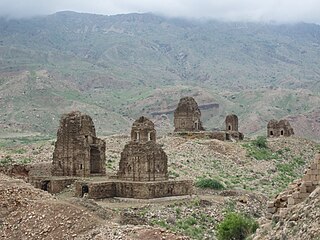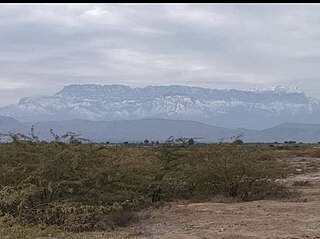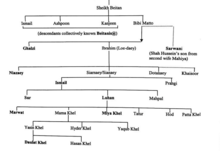
Khyber Pakhtunkhwa, formerly known as North West Frontier Province (NWFP), is a province of Pakistan. Located in the northwestern region of the country, Khyber Pakhtunkhwa is the fourth largest province of Pakistan by land area and the third-largest province by population. It is bordered by the Pakistani provinces of Balochistan to the south, Punjab to the south-east, the territory of Gilgit-Baltistan to the north and north-east, Islamabad Capital Territory to the east and Azad Kashmir to the north-east. It shares an international border with Afghanistan to the west. Khyber Pakhtunkhwa has a varied landscape ranging from rugged mountain ranges, valleys, plains surrounded by hills, undulating submontane areas and dense agricultural farms.

Dera Ismail Khan, abbreviated as D.I. Khan, is a city and capital of Dera Ismail Khan District, located in Khyber Pakhtunkhwa, Pakistan. It is the 37th largest city of Pakistan and fifth largest in the province of Khyber Pakhtunkhwa by population. Dera Ismail Khan is situated on the west bank of the Indus River, at its junction with the Gomal River.

Dera Ismail Khan District, often abbreviated as D.I. Khan is a district in the Dera Ismail Khan division of the Khyber Pakhtunkhwa province of Pakistan. The capital of the district is the town of Dera Ismail Khan. The district has an area of 9,334 km2 (3,604 sq mi) and a population of 1,627,132 as of the 2017 Census.
The Kharoti (Pashto:خروٹی) خروټی) are a Pashtun tribe of Ghilji origin, originating in the central part of Paktika Province, Afghanistan, but can be also found in other parts of the country. The Kharoti settled in Kharotabad in Quetta, British India around 1945.

Lodi is a Pashtun tribe from the Ghilji group of Pashtuns. In mythical genealogy, they have also been considered as being part of the Bettani tribal confederacy. The Lodi tribe consists of many sub-tribes, most of whom are now settled in the Tank, Frontier Region Tank, Lakki Marwat and Dera Ismail Khan districts of Khyber Pakhtunkhwa province of modern-day Pakistan. These tribes were nomadic for most of their existence and migrated to their present-day locations by crossing the Gomal Pass throughout different times in history.

The Gomal is a 400-kilometre-long (250 mi) river in Afghanistan and Pakistan. It rises in northern Afghanistan's Paktika Province. It joins the Indus River 20 miles south of Dera Ismail Khan, Khyber Pakhtunkhwa province of Pakistan.
Sur, are a historical Pashtun tribe from among the Kakar living primarily in what is now Afghanistan and Pakistan. They claim descendance from Arab general Khalid ibn al-Walid. The founder of the Suri Empire in India, Sher Shah Suri, belonged to the Sur tribe. They ruled the Suri Empire from 1540 until they were removed from power in 1555 after the Battle of Sirhind by Humayun and the Persian army, who re-established the Mughal Empire.

The Mianwali District is a district located in the Mianwali division of the Punjab province of Pakistan.

Tank District is a district in the Dera Ismail Khan Division of the Khyber Pakhtunkhwa province of Pakistan.

The Bettani, also spelled Batani, Baittani or Bhittani, is a Pashtun tribe located mostly in Afghanistan and Pakistan. The Bettani are named after Shaykh Beṭ, their legendary ancestor, who is said to be the third and last son of Qais Abdur Rashid.
Miani is a Pushtun nomadic tribe that mainly inhabit the Gomal plains of Pakistan in the Tank District of Khyber Pakhtunkhwa, which was formerly North-West Frontier Province.
Multan in Punjab province of Pakistan is one of the oldest cities in South Asia, though its exact age has yet to be determined. Multan remained the capital and largest city of Punjab region in late ancient and most of the medieval era. The Multan region was centre of many civilizations throughout its history, and has witnessed warfare across millennia because of its location on a major invasion route between South and Central Asia. Multan reached the height of its splendour during the Arab rule of 9th and 10th century when it was made a separate state, the Emirate of Multan, as it controlled large parts of Punjab and Kashmir. It is famous for its Sufi shrines. Multan province was one of the largest and first-established provinces of the Mughal Empire.
Dera Ismail Khan Tehsil is a tehsil located in Dera Ismail Khan District, Khyber Pakhtunkhwa, Pakistan.

Daraban is a tehsil located in Dera Ismail Khan District, Khyber Pakhtunkhwa, Pakistan. It is located at 31°44'3N 70°20'11E and has an altitude of 221 metres (725 ft). Daraban is a small town which lies 40 miles (64 km) west of Dera Ismail khan in the foothills of Sulaiman Mountains. Daraban region has a rich, fascinating history. Over the last two decades or so, Daraban has seen massive growth, becoming a vibrant hub of local trade and business.This has led to influx of economic migrants from neighboring villages, who have begin to settle in outskirts of Daraban, causing an increase in Town's population. Daraban enjoys excellent geographical condition, it lies on major national highway connecting Khyber Pakhtunkhuwa and Punjab with eastern parts of Balochistan.The town recent history includes events like high profile insurgent led attack on Draban's police station which led to deaths of 23 security personnels. This was only occasion when town gained media attention in Pakistan and abroad. December 12,2023 attack and more recent one in Chaudwan on February 5,2024 reflect heightened security threats in the region.

The Khugyani, Khogyani or Khogiani tribe is one of the Karlāṇī tribes of the Pashtun people. The tribe originated in the Khogyani district in Nangarhar province of Afghanistan. The Khogyani District is in eastern Nangarhar province of Afghanistan, near the city of Jalalabad and the Kōh-i-Safēd.
The Zadran, also spelled Dzadran or Jadran, jandran, is a Pashtun tribe that inhabits the Loya Paktia region in southeastern Afghanistan and parts of Waziristan in neighboring Pakistan. "Zadran: Pashtun tribe mainly residing in the “Zadran Arc” a 9-district area encompassing portions of the Khost, Paktya, and Paktika provinces."

Barozai is a clan of Balailzai, a Pashtun tribe in Afghanistan and Pakistan. Panni (Panri) are also known as Balailzai. The Panni are descended from Gharghasht, one of Qais Abdur Rashid sons. Originated from present Pakistan-Afghanistan border and then mostly resettled in Karachi, Quetta, Zhob, Sibi, Sangan, Musakhail, Harnai, Dera Ismail Khan, Ziarat, Mardan, Peshawar, Kabul, Tank, Kohat.
Daajal is a Tehsil in the south-west of Punjab, Pakistan. It is located in newly created Jampur District. It has a population of around 200,000, and the main languages spoken are Saraiki and Balochi.
The Mirani is a sub-branch of Dodai, which was influential in Derajat between the 15th and 18th centuries. The dynasty was founded by Kamal Khan, a descendant of Sohrab Khan Dodai, the founder of Dera Ghazi Khan. From 1550, the dynasty became stronger and more authoritative in Derajat and held it till 1787.

The Langah Sultanate, also known as the Sultanate of Multan, was a medieval kingdom established and ruled by the Lāngah clan in South Punjab from 1445 to 1540. Their capital was the city of Multan.












